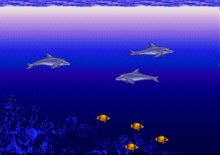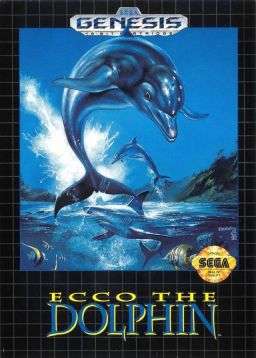Ecco the Dolphin
| Ecco the Dolphin | |
|---|---|
|
Box art of the North American release of Ecco the Dolphin. Painting by Boris Vallejo. | |
| Developer(s) | Novotrade International |
| Publisher(s) | Sega |
| Designer(s) | Ed Annunziata |
| Composer(s) |
Mega Drive: Spencer Nilsen Brian Coburn András Magyari Mega-CD: Spencer Nilsen Game Gear: Csaba Gigor Gábor Foltán |
| Platform(s) | Sega Mega Drive, Mega-CD, Microsoft Windows, Game Gear, Master System, Game Boy Advance, Nintendo 3DS |
| Release date(s) |
Sega Mega Drive
Mega-CD
Windows
iOS
|
| Genre(s) | Action-adventure game |
| Mode(s) | Single-player |
Ecco the Dolphin is an action-adventure game originally developed by Ed Annunziata and Novotrade International for the Mega Drive and published by Sega in 1992. Ecco the Dolphin was republished digitally via Nintendo's Virtual Console in 2006,[1] Microsoft's Xbox Live Arcade,[2] Steam,[3] iOS, and Nintendo 3DS.
It is the first installment in the Ecco the Dolphin video game franchise. The player character, Ecco, is a bottlenose dolphin who travels through time to combat hostile extraterrestrials in Earth's oceans and on an alien spacecraft.
Gameplay

Attacking enemies is accomplished by making Ecco ram into them at high speeds. Swimming can be made progressively faster by tapping a certain button, and the speed can be maintained by holding it down. Players can perform a purely aesthetic spin in the air when jumping out of the water.
Two features of the game play on actual dolphin habits; one button causes Ecco to sing, allowing him to speak with other cetaceans and interact with certain objects. The same button is used for echolocation; holding it down causes the song to return, generating a map of the area. Several levels contain enormous crystals called glyphs, which respond in different ways if Ecco touches or sings to them. Some block paths, and a "Key-Glyph" must be found in such cases to pass. Others give information, and a few in later levels replenish health/air and give Ecco temporary invulnerability.
Additionally, Ecco, being a mammal, must surface periodically for air, or else find an air vent. If the "air meter" runs out, Ecco loses health rapidly, which represented drowning. His health is measured by a separate meter (above the air meter); it is depleted by enemies or when his air meter runs out, and it is recharged by eating fish, "singing" to clams, or, later in the game, singing to special statues or crystals called "glyphs". Ecco's song can be optionally upgraded at two points in the game: one upgrade allows Ecco's song to be used in combination with a charge as a long-range weapon, and the other temporarily disorients sharks and makes minor enemies freeze temporarily. Touching any enemy by any means other than an attack causes Ecco to sustain damage. The enemies range from seahorses to giant octopodes.
The penultimate level of the game is titled "Welcome to the Machine", named for "Welcome to the Machine", the second song on Pink Floyd's 1975 studio album Wish You Were Here. Ecco: The Tides of Time (1994) features a level called "New Machine", named for "A New Machine", a two-part song on Pink Floyd's 1987 album A Momentary Lapse of Reason.[4]
Plot
The game begins with Ecco a Bottlenose Dolphin as he and his pod are swimming in their home bay. One podmate challenges him to see how high into the air he can jump. When he is in the air, a waterspout storm forms and sucks up all marine life in the bay except Ecco, leaving him alone in the bay. Upon leaving the bay to search for his pod, he contacts several Dolphins, Pilot Whales, False Killer Whale and Porpoises from other pods, who tell him the entire sea is in chaos, and that all marine creatures had felt the storm. An orca tells Ecco to travel to the Arctic to find a blue whale named the "Big Blue", who is revered among marine mammals for its age and wisdom. Ecco meets pods of Beluga Whale and Narwhals. While trying to find the Big Blue in the Arctic Ecco was almost attacked by a Polar Bear. A Narwhal saves Ecco from the Polar Bear. The Narwhal helps Ecco find the Big Blue. Once Ecco finds him, the Big Blue tells him such storms had been occurring every 500 years and directs him to the Asterite, the oldest creature on Earth. He leaves the Arctic and travels to a deep cavern where he finds the Asterite. Although it has the power to aid him, one of its globes is missing, and needs it returned. However, this can only be achieved by traveling back in time using a machine built by the ancient Atlanteans.
Ecco travels to the sunken city of Atlantis, where he discovers the time machine and an ancient library. He learns the cause of the storm; it was a harvest of Earth's waters that was conducted every 500 years by an alien species known as the Vortex. The Vortex had lost their ability to make their own food, and so every 500 years, they would harvest from the waters of Earth. Learning this, he activates the time machine and travels 55 million years into Earth's past. While Ecco is in the past a Kronosaurus chases Ecco. Ecco jumps out of the water and is saved by a Pteranodon. The Pteranodon carries Ecco high. Ecco sees dinosaurs. The Pteranodon drops Ecco in the water. Ecco locates the Asterite in the past but is immediately attacked by it. Forced into battle, he manages to dislodge a globe from it. This opens a time portal and he is sent back into the present. After receiving the globe, the Asterite grants him the power to turn his sonar into a deadly weapon against the Vortex, as well as the abilities to breathe underwater and to slowly regenerate lost health. The Asterite instructs him to use the time machine to travel back in time to the hour of the harvest. This time he manages to be sucked into the waterspout with his pod. Once inside the waterspout, Ecco makes his way towards the Vortex Queen, the leader of the Vortex race. Eventually, the Vortex Queen is destroyed and Ecco rescues his pod.
Development
After deciding to create a game based around dolphins, developer Ed Annunziata carried out research on the subject and was particularly inspired by the book Sounding by Hank Searls which explained how the creatures use echolocation.[5] Annunziata worked with the music team on the soundtrack, playing them songs by Pink Floyd to illustrate the feeling he was aiming for.[5] Annunziata later said, "I was paranoid about game rentals and kids beating the game over the weekend. So.. I.. uh... made it hard."[6] His favourite level was Welcome to the Machine, which was "way over the top challenging"[5]
The name Ecco comes from John C. Lilly, where, during his experiments with psychoactive drugs, he claims to have met a series of cosmic entities dubbed Earth Coincidence Control Office (E.C.C.O.). In his life, Lilly was involved in extensive research involving dolphins, compiling his work's findings in the book The Mind of the Dolphin.[7] The game takes much inspiration from Lilly's work with dolphins and his experiments with psychedelic substances.[8] Ed Annunziata himself has stated on his Facebook page: "I did read a lot from John C Lilly."[9]
Release
Ecco the Dolphin was originally released in 1992 for the Sega Mega Drive (Genesis).
Game Gear and Master System
The Sega Game Gear and Sega Master System versions were also released; they featured different levels to the other versions and a special intro featuring a whale song, and dolphin noises for the title screen. The Game Gear version had some notable features in that were not present in the Mega Drive version. These included a dolphin "SEGA" on the SEGA screen and dolphins laughing on the title screen, along with a new soundtrack by Csaba Gigor and Gábor Foltán, as well as a wider color gamut.
Sega Mega-CD and Windows
An enhanced Sega Mega-CD version that features new and redesigned levels and an alternate Red Book audio soundtrack, composed by Spencer Nilsen, was also released. This version was later ported to Windows. The Windows port was further enhanced with higher resolution graphics.
Sega Mega Drive Collection/Sega Genesis Collection
Ecco the Dolphin, along with Ecco: The Tides of Time and Ecco Jr., can be found on the PlayStation 2, and PlayStation Portable game Sega Genesis Collection.
RealOne Arcade
In 2002, Sega's first attempt to enter the downloadable retail game content business occurred on RealOne Arcade. The first few titles released included Ecco the Dolphin, Columns III and Shinobi III. These downloadable releases came in one-hour trial versions.
Virtual Console
Ecco the Dolphin was released in Europe and Australia for the Virtual Console on Nintendo's Wii console on December 8, 2006 for 800 Wii Points.[1] It was released in North America on November 28, 2006 for 800 Wii Points, and in Japan on December 2, 2006 for 600 Wii Points.[1]
Xbox Live Arcade
Ecco the Dolphin was released on the Xbox Live Arcade for a price of 400 MS Points on August 15, 2007 for the Xbox 360.[2]
Sega Mega Drive Ultimate Collection/Sonic's Ultimate Genesis Collection
Ecco the Dolphin is part of Sonic's Ultimate Genesis Collection for Xbox 360 and PlayStation 3, along with its sequel.
Nintendo 3DS
3D Ecco the Dolphin is a port of the game for the Nintendo 3DS as part of Sega's 3D Classics line. Along with stereoscopic 3D graphics and the option to choose between Japanese and International versions of the game, the port also adds 'Super Dolphin Mode', which decreases the difficulty by giving players invincibility and unlimited oxygen. The game was released on the Nintendo eShop in Japan on June 26, 2013, and in North America and Europe on December 12, 2013.[10]
Reception
| Reception | ||||||
|---|---|---|---|---|---|---|
| ||||||
| ||||||
The Sega Mega Drive version became a bestseller.[12] Mega placed the game at #24 in their Top Mega Drive Games of All Time.[13] On release, Famicom Tsūshin scored the Mega-CD version of the game a 27 out of 40.[14]
References
- 1 2 3 "Wii.Nintendo.com - Wii Virtual Console games - Ecco the Dolphin". Nintendo. Nintendo. 2007. Archived from the original on 2007-05-18. Retrieved 2007-09-25.
- 1 2 "Ecco the Dolphin - Game Detail Page". Microsoft. Microsoft. 2007. Archived from the original on 2007-08-23. Retrieved 2007-09-25.
- ↑ "Ecco the Dolphin™ on Steam". Store.steampowered.com. Retrieved 21 November 2014.
- ↑ "Arkonviox.com - Welcome to the Machine and Pink Floyd".
- 1 2 3 "Sef's Interview with Ed Annunziata, Game Designer of Ecco the Dolphin - Gaming Furever". Gamingfurever.com. Retrieved 21 November 2014.
- ↑ "285469578635640832." Ed Annunziata at Twitter. Retrieved on January 30, 2013.
- ↑ Lilly, John Cunningham (1 May 2015). "The Mind of the Dolphin: A Nonhuman Intelligence". Gateways Books & Tapes. Retrieved 6 September 2016 – via Google Books.
- ↑ "The Ketamine Secrets of Sega's 'Ecco the Dolphin' - VICE - United Kingdom". 16 March 2015. Retrieved 6 September 2016.
- ↑ "Ecco the Dolphin: Caverns of Hope - Timeline - Facebook". Retrieved 6 September 2016.
- ↑ "3D Ecco the Dolphin Has Rebalanced Difficulty And Two Versions In One". Siliconera. Retrieved 21 November 2014.
- ↑ MegaTech rating, EMAP, issue 22, page 98, October 1993
- ↑ Official Gallup UK Mega Drive sales chart, April 1993, published in Mega issue 7.
- ↑ Mega magazine issue 26, page 74, Maverick Magazines, November 1994.
- ↑ NEW GAMES CROSS REVIEW: エコー・ザ・ドルフィン CD. Weekly Famicom Tsūshin. No.324. Pg.41. 3 March 1995.
Nintendo Official Magazine Staff (2001). Nintendo Official Magazine - Nintendo's Market Share 1988. Future Publishing. p. 35.
| Wikiquote has quotations related to: Ecco the Dolphin |
